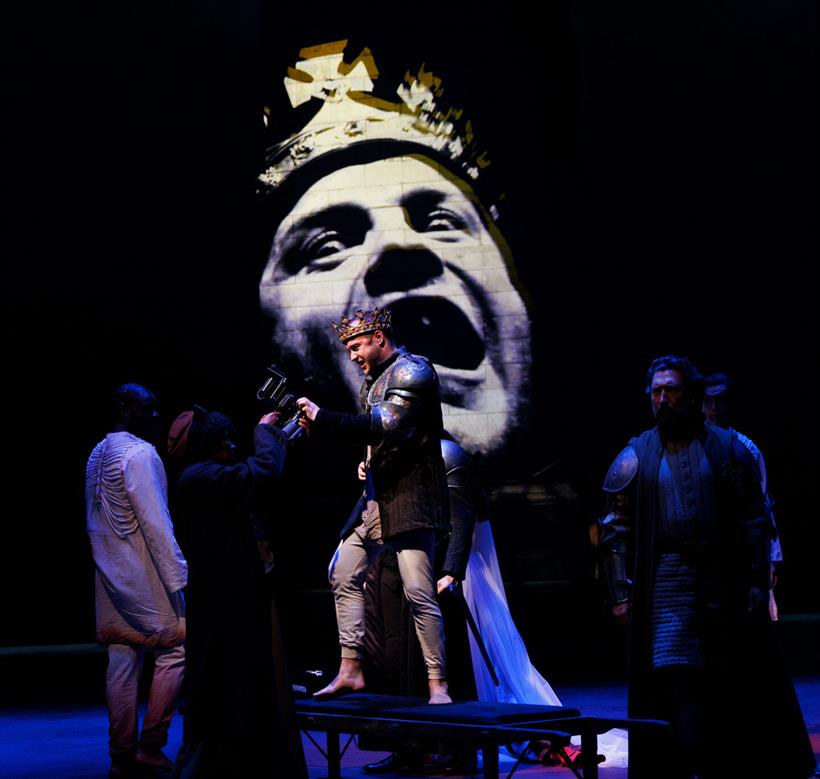Shakespeare's Richard III RSC Stratford Upon Avon

A Review by Jane Kelly.
The impact of woke culture has changed the theatre so that I can barely recognise it. Representing this new ideology and promoting minorities appears more important than finding talent or respecting an original script. In this RSC production of RICHARD III, the action on stage seemed fragmented, lines were thrown away, poetry and rhythm ignored and no character stood out, even the king. I began to feel bored and this was once one of my favourite plays.
The famous opening, ‘Now is the winter of our discontent’ was somewhat lost as the stage filled with young people dashing around, and Richard, played by Arthur Hughes, hardly projected it. He could have really been discussing the weather. As he ran about the stage with the others, I had a feeling of apprehension as I noticed he’d got no hump. This was ‘Crookback’ with no cruck, the ‘poisonous bunch-backed toad,’ as Queen Margaret calls him, or ‘Bent Dicky’ as he was called by fond relatives in Henry VI - here, not in the least bit bunched or bent. Hughes significantly does have a deformed arm and is being hailed as the RSC’s first disabled actor.
It was finally proved in 2012 when Richard Plantagenet was dug up under a car park, and his skeleton examined, that he had scoliosis and a damaged arm. According to the rules of Woke, an actor who does not have those problems cannot play that part because acting is now all about, ‘The lived experience’ of the actor. There was probably no actor with both a twisted spine and a damaged arm available, but this was near as possible. It’s doubtful that any of the great, able-bodied actors who once took the role, Laurence Olivier, Antony Sher, who was married to Greg Doran the director of this version, or Ian McKellen, would ever be allowed near it now. Their memory must be consigned to our shameful past. It’s questionable whether this rule applies in reverse, as actors in the ‘protected categories’ seem to be able to have it both ways.
Women are increasingly important in British cultural life, taking most top directorial and curatorial jobs and leading male roles, but in this they were dull as mice. Richard III is usually a good play for feisty feminists as Richard is ‘hag-ridden’ as he might have put it, surrounded by females who hate him and make their feelings plain through searing, wounding speech. Queen Margaret, whom Crookback calls a ‘foul, wrinkled witch’, looked about twenty-five in a sexy red evening dress, but she limped about as if she was old, which was confusing. The lines on her face were invisible, and those coming from her mouth were almost inaudible. Worse, Richard’s mother, played by a cosy looking black actress in a bandana, rather than expressing bitter loathing for her son which usually adds another layer of brutality and complexity to the play, showed as much ire as if he’d failed to tidy his bedroom.
Drifting off in that unpleasant way where your eyes get heavier and your head keeps snapping up as you struggle to keep awake, I was roused by school children armed with packets of crisps and large bottles of Coca-Cola. They didn’t talk; just stuffed themselves. An attendant went into action and I had to keep standing up to let her past as she desperately tried to identify the loudest crisp eaters. Another one worked along another row, trying to stop the Coke quaffing, but the picnicking noises went on until the interval. The children, from Southam College, in Warwickshire, were charming, and slightly bewildered. Their teachers hadn't told them that when you go to the theatre, you eat in the interval, not during the play.
The duty manager apologised and gave us better seats in the stalls, where we were much closer to the actors with no escape into furtive slumber. The play limped on, not even enlivened by the usual violence. All deaths, even of Clarence, drowned in a butt of Malmsey wine, happened off stage. Richard ran about looking as peevish and forceful as Pike in Dad’s Army. The set included a facsimile of the London cenotaph, which was used to project the faces of two out of the eleven ghosts who visit Richard before the battle of Bosworth. What happened to the other aggrieved spectres is anyone’s guess. That moving if sinister pre-battle scene was dissolved into nothing.
We did get to hear, ‘My kingdom for a horse!’ but not in a way that I thought the school children, now largely quiet with only the odd crunch and swig, would remember. A wreath was for some reason laid on the cenotaph and I emerged into the evening air saddened that all the children would take away from this production, was the discovery of some rules about eating in the theatre, and probably not be too bothered, as it’s doubtful they’ll be back. There was nothing to hold them.
Richard III is showing at the Royal Shakespeare Theatre, Stratford until 8th October 2022